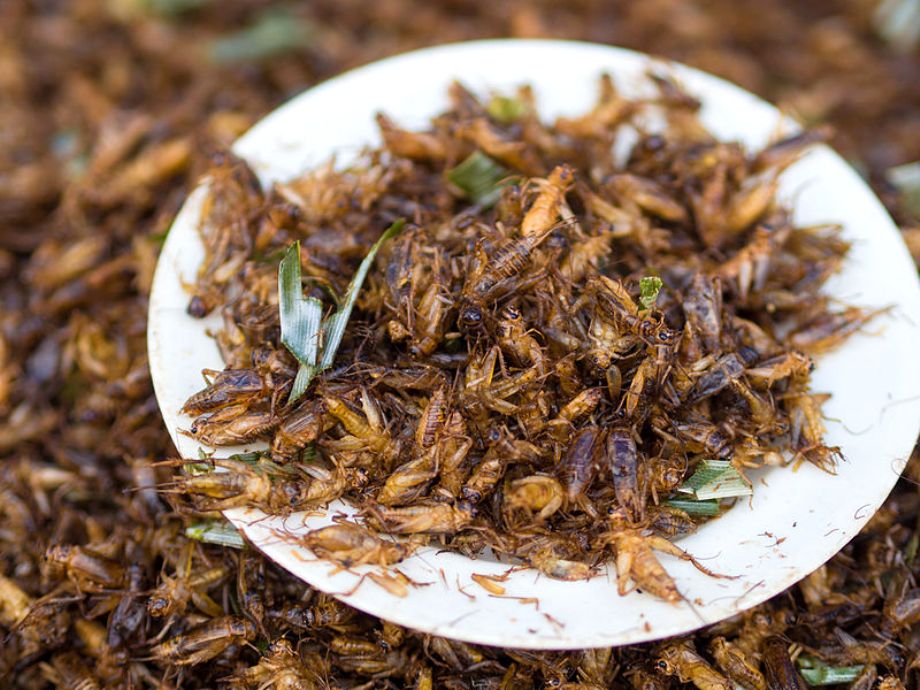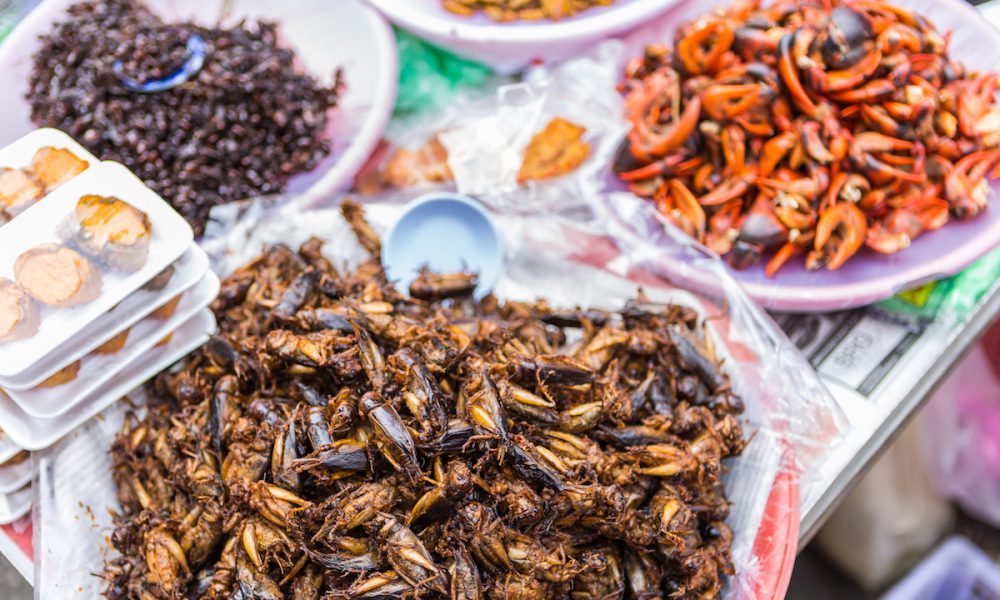
On this month's Oddities in the News Page:
Crickets on the menu as the world looks for new sources of food for a starving planet
IN THE ODDITIES ARCHIVES
Mummy Scan
Roswell
Weird Things Animals Ate
Dogs Smell Covid
Kyrgyz cricket farm hopes to tap Chinese insects market

BISHKEK (Reuters, August 10, 2021) - With one eye on the lucrative Chinese market just across the border, an entrepreneur has launched Kyrgyzstan's first cricket farm and is producing high-protein insect flour and fried cricket snacks.
Accompanied by loud chirping from his one tonne of crickets at the farm, Adyl Gaparov said his idea was inspired by online articles about breeding crickets.
"Our main business is producing cricket flour with high protein content," Gaparov said. "Our flour contains no less than 70% of protein and many micro and macro elements."
Gaparov has about one tonne (2,200 pounds) of live crickets at his farm, but he says serious business such as shipments to China starts with at least five-tonne cargoes. He is offering flour for sale at 7,000 soms ($82) per kilogram.
"We are in talks with several companies that are looking to procure large quantities of powder - which we cannot produce at the moment - to make sports protein bars, for example, for athletes and for people trying to lose weight," he says.
Gaparov says that to thrive, crickets need above all a stable temperature above 30 degrees and minimal humidity.
"In this regard, Kyrgyzstan is ideally suited for cricket farming. We can open such farms literally in every province and export the produce," he says. "China consumes 30,000 tonnes of insects a year, but only produces 20,000 tonnes."
Despite the abundance of guides and manuals online, Gaparov says he had to learn through trial and error.
"Over half a year, there were three cases where we lost a whole generation overnight," he says.
While he grows his swarm and builds up cricket flour stocks, Gaparov also sells deep-fried insects as a beer snack.
"We add some spices and flavourings," he says.
(Reporting by Marlis Myrzakul uulu; Writing by Olzhas Auyezov; Editing by Raissa Kasolowsky)
See more HERE
TIME Magazine suggests that eating insects could save the world

TIME Magazine: They're Healthy. They're Sustainable. So Why Don't Humans Eat More Bugs?
he United Nation’s Food and Agriculture Organization [FAO] says that agricultural production worldwide will have to increase by 70% in order to feed a global population expected to reach 9.1 billion by 2050. Yet agriculture is one of the biggest drivers of natural destruction, threatening 86% of the 28,000 species most at risk of extinction, according to a new report by the UK-based policy institute Chatham House and the UN environment program.
Demand for animal protein in particular is increasing the strain on the environment: 80% of the world’s farmland is used to raise and feed livestock, even though animals only account for 18% of global calorie consumption. Decreasing meat production, says the report, would remove pressure to expand livestock operations while freeing up existing land to restore native ecosystems and increase biodiversity.
There is a sustainable alternative to going meat-free, the FAO says: edible insects. Grasshoppers, crickets and mealworms are rich in protein, and contain signicantlyhigher sources of minerals such as iron, zinc, coppper, and magnesium than beef. Yet pound for pound they require less land, water and feed than traditional livestock. Insect farming and processing produces significantly lower greenhouse gas emissions. Not only do insects produce less waste, their excrement, called frass, is an excellent fertilizer and soil amender. Agnes Kalibata, the UN Secretary-General António Guterres’ special envoy for the 2021 Food Systems Summit, says that farming insects could provide an elegant solution to the intertwined crises of climate change, biodiversity loss, hunger and malnutrition. “Insects are 60% dry weight protein. I mean, honestly, why wouldn’t we use them?” she says. “But we have to be able to put them in a form that is acceptable to different cultures and different societies.”
In order to compete, manufacturers will have to figure out how to successfully market bugs to consumers. The sustainability halo and health aspects may be enough for some, but are unlikely to work on a wider scale, says Cortni Borgerson, an anthropology professor at Montclair State University in New Jersey. “You can’t just say, ‘this source of protein you’ve been eating all your life? Well you can’t have that anymore. Here’s another source, and it’s got six legs instead of four.’ That will never work.” The goal, she says by video chat from New Jersey, should be “to find something that people would rather be eating, or would like just as much.” In other words, insects have to taste at least as good as what they are meant to replace.
In the taste stakes, crickets still come up short. Fried and dusted with chili lime or nacho spice, they don’t taste much different from say, corn nuts or extra crispy shrimp. In powder form, it has a mild, nutty flavor and is best used like a protein boost, sprinkled over porridge, stirred into a vegetarian chili or folded into banana bread batter. Devotees say they can’t get enough, but even they admit that crickets may have a hard getting past that most damning of descriptions—a meat alternative. Madagascar, however, has a better contender: the bacon bug.
See more HERE
What countries eat insects?

The dominant insect eating countries are the Democratic Republic of the Congo, Congo, the Central African Republic, Cameroon, Uganda, Zambia, Zimbabwe, Nigeria and South Africa. The most commonly eaten insects include caterpillars, termites, crickets and palm weevils.
However, these countries also eat insects and it may surprise you who they are:
Thailand
Many Thais love snacking on grasshoppers, crickets and woodworms.
The bugs are seasoned and fried in a wok until crispy, then served to passers-by at local food markets. Ant eggs, like the ones shown here, are also popular.
Ghana
During the springtime, when food is scarce, Ghanaians rely on termites as their main source of protein. The insects can be roasted, fried or even used to make bread. Termites are best known for creating these elaborate homes (and destroying ours).
Mexico
In Mexico, bugs are eaten in a variety of ways: fried, buttered or even dipped in chocolate. But perhaps the most renowned method is to drink them. Mezcal, a Mexican liquor (sometimes confused with tequila), is often served with a worm ready for swallowing.
China
In China, roasted larvae from insects like bees are a delicacy served in high-end restaurants. But on the street, you’ll find fully grown insects like these water bugs roasted or fried and then skewered to make them easy to eat on the go.
Brazil
Queen ants, or içás, were traditionally consumed only by poorer families. Today, these bite-sized morsels are a popular snack in the town of Silveiras in southwest Brazil. Townsfolk claim that these winged bugs taste just like mint.
Australia
Insects like the honey-pot ant have been consumed by Australia’s Aboriginal tribes for centuries. These bugs ingest food and store it in their bodies, making them an excellent source of essential nutrients for bug-eating humans.
Japan
Bugs are crawling on to menus all across Japan. Some favorites include inago (fried grasshopper), sangi (fried silk moth pupae) and Zaza-mushi (a type of larvae).
The Netherlands
The Netherlands is slowly embracing the idea of eating insects. Johan Van Dongen (head of the meat department for the Dutch food distributor, Sligro) is helping to encourage the Dutch to rely on insects (like crickets) as a source of protein by offering a free taste from a stand on the sidewalk in the city of ‘s-Hertogenbosch.
See more HERE